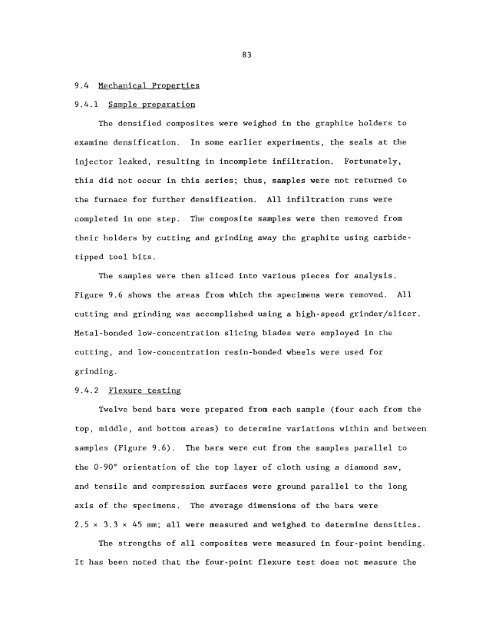Characterization and control of the fiber-matrix interface in ceramic ...
Characterization and control of the fiber-matrix interface in ceramic ...
Characterization and control of the fiber-matrix interface in ceramic ...
Create successful ePaper yourself
Turn your PDF publications into a flip-book with our unique Google optimized e-Paper software.
83<br />
9.4 Mechanical ProDerties<br />
9.4.1 Sample vreoaration<br />
The densified composites were weighed <strong>in</strong> <strong>the</strong> graphite holders to<br />
exam<strong>in</strong>e densification. In some earlier experiments, <strong>the</strong> seals at <strong>the</strong><br />
<strong>in</strong>jector leaked, result<strong>in</strong>g <strong>in</strong> <strong>in</strong>complete <strong>in</strong>filtration. Fortunately,<br />
this did not occur <strong>in</strong> this series; thus, samples were not returned to<br />
<strong>the</strong> furnace for fur<strong>the</strong>r densification. All <strong>in</strong>filtration runs were<br />
completed <strong>in</strong> one step. The composite samples were <strong>the</strong>n removed from<br />
<strong>the</strong>ir holders by cutt<strong>in</strong>g <strong>and</strong> gr<strong>in</strong>d<strong>in</strong>g away <strong>the</strong> graphite us<strong>in</strong>g carbidetipped<br />
tool bits"<br />
The samples were <strong>the</strong>n sliced <strong>in</strong>to various pieces for analysis.<br />
Figure 9.6 shows <strong>the</strong> areas from which <strong>the</strong> specimens were removed. All<br />
cutt<strong>in</strong>g <strong>and</strong> gr<strong>in</strong>d<strong>in</strong>g was accomplished us<strong>in</strong>g a high-speed gr<strong>in</strong>der/slicer.<br />
Metal-bonded low-concentration slic<strong>in</strong>g blades were employed <strong>in</strong> <strong>the</strong><br />
cutt<strong>in</strong>g, <strong>and</strong> low-concentration res<strong>in</strong>-bonded wheels were used for<br />
gr<strong>in</strong>d<strong>in</strong>g.<br />
9.4.2 Flexure test<strong>in</strong>g<br />
Twelve bend bars were prepared from each sample (four each from <strong>the</strong><br />
top, middle, <strong>and</strong> bottom areas) to determ<strong>in</strong>e variations with<strong>in</strong> <strong>and</strong> between<br />
samples (Figure 9.6). The bars were cut from <strong>the</strong> samples parallel to<br />
<strong>the</strong> 0-90" orientation <strong>of</strong> <strong>the</strong> top layer <strong>of</strong> cloth us<strong>in</strong>g a diamond saw,<br />
<strong>and</strong> tensile <strong>and</strong> compression surfaces were ground parallel to <strong>the</strong> long<br />
axis <strong>of</strong> <strong>the</strong> specimens. The average dimensions <strong>of</strong> <strong>the</strong> bars were<br />
2.5 x 3.3 x 45 mm; all were measured <strong>and</strong> weighed to determ<strong>in</strong>e densities.<br />
The strengths <strong>of</strong> all composites were measured <strong>in</strong> four-po<strong>in</strong>t bend<strong>in</strong>g.<br />
It has been noted that <strong>the</strong> four-po<strong>in</strong>t flexure test does not measure <strong>the</strong>

















